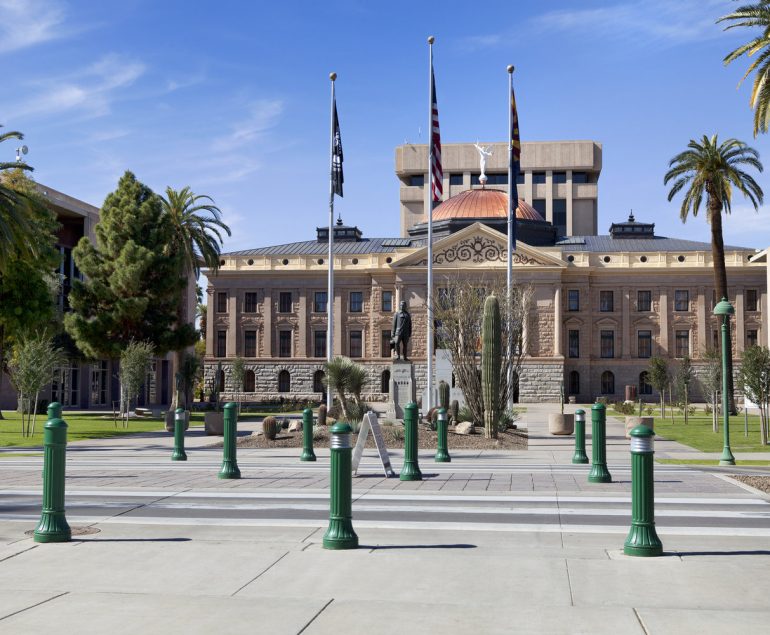The Governor announced a few tweaks to his current policies today in response to the eye opening trajectory of the COVID epidemic in Arizona. Despite clear evidence that we are on an exponential growth curve and headed for another hospital capacity crisis in December, only minor new efforts were announced today at his media conference.
-
He doubled the public service announcement budget for messages about how people should behave, reminding them to wash their hands, keep physically distant from others and to wear a mask. Many of the PSA’s feature audio and video of the governor or the health director. Others have more creative content.
-
The Phoenix, Tucson and Mesa airports will have testing stations where passengers can stop by for a free COVID rapid test.
-
Schools are now mandated to require that masks be worn on school campuses, on school buses, and during school-associated activities by all students, faculty, staff, contractors, and visitors. This is probably the most significant intervention that was mentioned at the press conference.
-
Hospitals will be receiving $25M in CARES Act money to pay for healthcare worker staff bonuses or to supplement their personnel costs.
-
An Executive Order was issued making it clear that the SARS CoV2 immunizations should be entered into the state’s immunization registry (called ASIIS) making it easier to track patients for their follow up SARS CoV2 booster shot.
Editorial Note: The measures announced today are wholly inadequate to prevent another hospital capacity crisis in Arizona (in December). Mitigation measures like a statewide, uniform, and enforceable face covering mandate (placing the responsibility for compliance on businesses and organizations) and far better enforcement of mitigation measures in bars and restaurants were needed many weeks ago. Had they been implemented in October when the case rate and trajectory began to increase, those interventions would have been able to slow down the spread enough to decrease the likelihood of a hospital crisis in December.
Many weeks of opportunities to benefit from better enforcement in bars and restaurants and a uniform and enforceable statewide mask mandate (with enforcement focused on businesses and organizations rather than individuals) have now been missed. Because of that, far more stringent measures would be needed at this point to prevent a hospital capacity crisis. Today’s announcements were trivial and will have a negligible effect.
In my opinion, the die is cast, and we are headed for an early or mid-December hospital capacity crisis possibly including Crisis Standards of Care. The December crisis will likely be worse than our summer fiasco because there will be very few out-of-state healthcare workers to contract with, our seasonal population of at risk persons is increased now, and July represented the low-point of our normal seasonal hospital census.
Sadly, the coming hospital capacity crisis and the resulting loss of life was likely avoidable with targeted and timely evidence-based interventions a few weeks ago.
Get ready folks.
Updated – Editorial Note II Regarding Bars & Restaurants:
I’ve been getting a fair amount of criticism from folks suggesting that I have been in favor of completely closing bars and restaurants and/or a broad-based stay at home order again. That is not the case. For the last many weeks, I have been in favor of much better enforcement of the existing required mitigation measures. Sadly, the opportunities to put together an efficient compliance system (and benefit from it) have been lost.
We’ve learned a lot about this virus and we now know that the virus thrives in closed indoor environments where people typically don’t wear masks. For the last many weeks I have been advocating for better enforcement of the existing mitigation measures that were required of bars, restaurants and nightclubs when they reopened after the June/July “pause”.
When these businesses started back up a couple of months ago, they were required to sign attestations that they’d follow required mitigation measures (restaurants at 50% capacity and bars operating like restaurants and also using capacity limits). While there is a complaint hotline and some follow up of those complaints (I’ve heard that many are simply phone calls) there is little if any proactive compliance checks and sporadic enforcement.
Any effective regulatory program requires routine proactive compliance checks that include enforcement when necessary. Had we been doing better proactive compliance checks, there would be far fewer bars, restaurants and nightclubs ignoring the existing mitigation requirements. Businesses that are complying are frustrated that their competitors are cheating and getting away with it. That causes more businesses to cheat.
But how could such a system have worked? There were at least 2 possibilities. The existing food safety workforce in AZ (called Sanitarians) could have been reassigned to COVID mitigation detail for the next few months. Alternatively, the National Guard (who is currently helping with the response on other areas like food banks and shelf stocking among other things) could have been put on mitigation compliance check detail at bars restaurants and nightclubs. An Executive Order could have given authority to nullify the Attestations made by those businesses that are not complying, suspending their individual operation.
If better compliance and enforcement had been in place several weeks ago, we would be in a different place. As it stands, we are now in exponential growth of the virus and likely headed for a hospital capacity crisis in December. When that happens, I think the Governor will have no choice but to shut the bars again.
My point has been that shutting the bars again could have been avoidable if better compliance and enforcement of the existing required mitigation measures had been in place many weeks ago.

